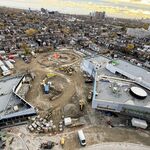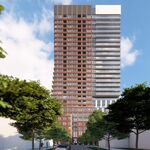I believe that the painted road at streetcar stops and pedestrian areas will come in the spring. No point in doing that now with snow season about to arrive and cover it up.
If it's flat concrete slabs bolted down to make them removable and create a plinth extension from the sidewalk to the streetcar, now is the time to do it. If you can use tapcons to attach yellow tactile strip to the asphalt, the same or less labour is involved in bolting down pre-cast concrete slabs to the road using bolt anchors. The colouring wasn't what I was referring to. I'm referring to the built form in the renderings offering streetcar riders a much safer and defined area to embark/disembark at the stops. It would also speed up doing so. Once a plinth is in place *then* yellow tactile strip can be used as it was meant to warn persons with visual disabilities as to where the edge of the curb is.
Yes, laws are ineffective unless they are enforced. How would adding a new law regarding tactile markings change that?
Thank you for making my point. And I never suggested "adding a new law". That would take far more time than the project is touted to last. My point is that it is now *unenforceable* for the purpose of safety for pedestrians, and the yellow tactile strip is very slippery when wet for cyclists and pedestrians alike. Many instances are detailed on-line, especially in cycling forums.
CityNews had a surprisingly great and balanced report on the King pilot yesterday:
We're starting to see traffic patterns emerge, and not the ones expected, as the Queen comparison *evidently* showed little impact on traffic flow. The flow seems to be taken north-south, not east-west.
The lack of cars on King has done a tremendous job of exposing how dull and drab this street is. Dirty streets, cracked and uneven pavement, narrow sidewalks, little public amenities or attractions, zero green converge, grey everywhere. This really is an unattractive stretch of road, and I'd be embarrassed to take tourists down here. The permanent installation of this project must include large-scale public realm improvements, in a similar vein to what we've done with Union Station. King is going to become an even more important tourist corridor, so it absolutely deserves this treatment. The street in its current state is a poor reflection on our city.
In my visits down there past two days, and pics taken, it's truly filthy and bleak. Let me flip that over though. It's not the lack of vehicular traffic, it's because of years of vehicular traffic that meant that corridor could never reach its potential. Old pics of King (BlogTO has a piece up right now
http://www.blogto.com/slideshows/king-street-1960s-1980s-toronto/13531 ) show a much leafier and softer, *more welcoming* street. At least in sections. Note how the eye sees the older King as much wider. The 'canyon effect' has taken a huge toll on King, and getting green growth along there might take a few horticultural tricks.
If this Project continues to produce results, then enthusiasm for making King welcoming will reach new heights. One only has to look at pics of Melbourne's Bourke Street and US examples (Portland, San Diego, et al) to see what can be done. Some have been failures, so it's essential to get the model right on this.
I have also not noted any appreciable increase in traffic volume on Adelaide heading west from Bathurst. Leaves me wondering where did all the cars go?
There's that "east-west" not showing increased flow again. It's very curious. Perhaps that might change, but it must be taking planners by surprise.
I had the same reaction when I went along King yesterday, but that's an opportunity statement rather than a complaint. It's too soon to say we have solved the streetcar problem on King, but it's a very promising start. Now, the other big opportunity is for the City to decide what's the best use of all that vacant street space.... sidewalks? cobblestones? grass?
It's time to get really, really creative. Usually I scoff when people suggest an International Design Competition boondoggle, but something that extravagant would not be wasted effort.
Just pics from the past show be a good starting point to expand on. A lot can be done.
If this is made permanent I am sure public realm improvements can be made to more than compensate any negative impact.
Magnitudes more. Five years from now, people will most likely be asking: "Why didn't we do this decades ago?". But alas, that's Toronto's song.




